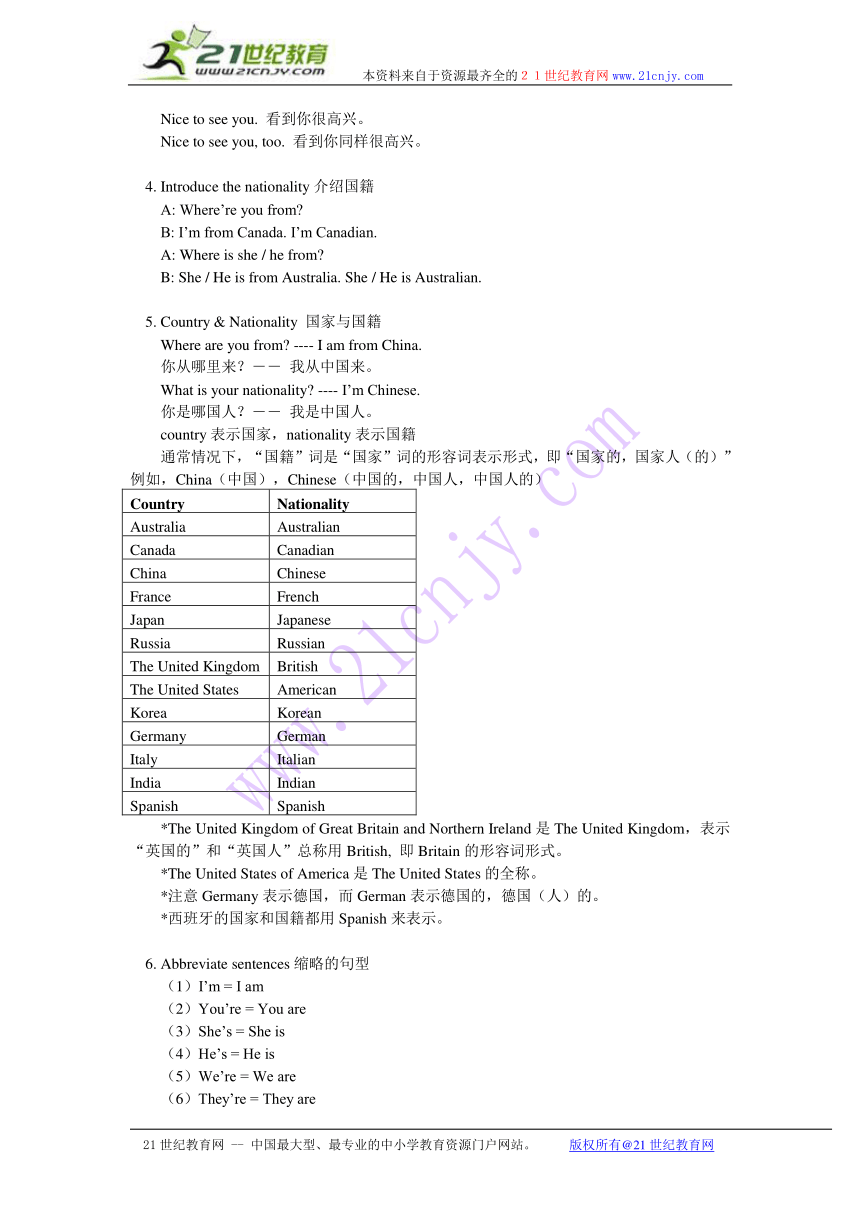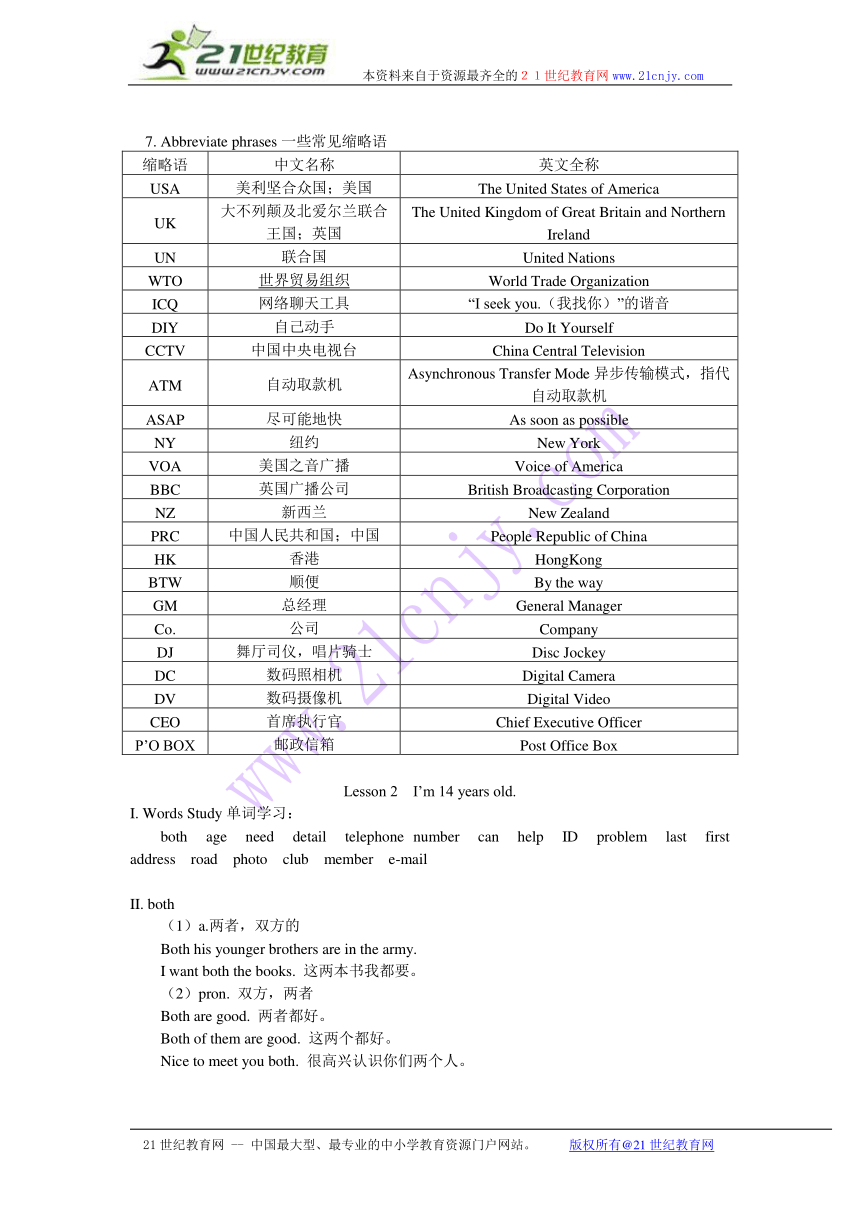英语:unit 1 meeting people语法讲解1(北师大版七年级上)
文档属性
| 名称 | 英语:unit 1 meeting people语法讲解1(北师大版七年级上) |  | |
| 格式 | rar | ||
| 文件大小 | 18.3KB | ||
| 资源类型 | 教案 | ||
| 版本资源 | 北师大版 | ||
| 科目 | 英语 | ||
| 更新时间 | 2009-08-20 21:56:00 | ||
图片预览



文档简介
本资料来自于资源最齐全的21世纪教育网www.21cnjy.com
Unit One Meeting People (1)
一.教学内容:
Lesson 1 Hello. My name is Melissa.
Lesson 2 I’m 14 years old.
二. 重点、难点:
学会介绍自己和别人
学会和别人打招呼
学会介绍国家和国籍
Lesson 1 Hello. My name is Melissa.
I. Words Study单词学习:
spell nationality Australian Canadian Chinese French Japanese Russia Russian United Kingdom British American
II. Expression patterns常用的表达方式:
1. Introduce oneself介绍自己
A: What is your name
B: My name is XXX. / I’m XXX.
A: What’s her/his name
B: It’s XXX. / She/He is XXX. / Her/His name is XXX.
2. How to spell one’s name姓名的拼写
A: How do you spell that
B: S-T-E-V-E-N
3. Greeting strangers向陌生人问候
A: Nice to meet you, Steven.
B: Nice to meet you, too.
相同的表达方式还有:
It’s nice to meet you.
It’s nice to meet/see you, too.
Nice meeting you.
Same here.
Glad to meet you.
Glad to meet you, too.
I’m glad to meet you.
I’m glad to meet you, too.
I’m pleased to meet you.
I’m pleased to meet you, too.
meet 也可以换成see,meet表示遇见,认识,see表示看到。
Nice to see you. 看到你很高兴。
Nice to see you, too. 看到你同样很高兴。
4. Introduce the nationality介绍国籍
A: Where’re you from
B: I’m from Canada. I’m Canadian.
A: Where is she / he from
B: She / He is from Australia. She / He is Australian.
5. Country & Nationality 国家与国籍
Where are you from ---- I am from China.
你从哪里来?―― 我从中国来。
What is your nationality ---- I’m Chinese.
你是哪国人?―― 我是中国人。
country表示国家,nationality表示国籍
通常情况下,“国籍”词是“国家”词的形容词表示形式,即“国家的,国家人(的)”
例如,China(中国),Chinese(中国的,中国人,中国人的)
Country Nationality
Australia Australian
Canada Canadian
China Chinese
France French
Japan Japanese
Russia Russian
The United Kingdom British
The United States American
Korea Korean
Germany German
Italy Italian
India Indian
Spanish Spanish
*The United Kingdom of Great Britain and Northern Ireland是The United Kingdom,表示“英国的”和“英国人”总称用British, 即Britain的形容词形式。
*The United States of America是The United States的全称。
*注意Germany表示德国,而German表示德国的,德国(人)的。
*西班牙的国家和国籍都用Spanish来表示。
6. Abbreviate sentences缩略的句型
(1)I’m = I am
(2)You’re = You are
(3)She’s = She is
(4)He’s = He is
(5)We’re = We are
(6)They’re = They are
7. Abbreviate phrases一些常见缩略语
缩略语 中文名称 英文全称
USA 美利坚合众国;美国 The United States of America
UK 大不列颠及北爱尔兰联合王国;英国 The United Kingdom of Great Britain and Northern Ireland
UN 联合国 United Nations
WTO 世界贸易组织 World Trade Organization
ICQ 网络聊天工具 “I seek you.(我找你)”的谐音
DIY 自己动手 Do It Yourself
CCTV 中国中央电视台 China Central Television
ATM 自动取款机 Asynchronous Transfer Mode异步传输模式,指代自动取款机
ASAP 尽可能地快 As soon as possible
NY 纽约 New York
VOA 美国之音广播 Voice of America
BBC 英国广播公司 British Broadcasting Corporation
NZ 新西兰 New Zealand
PRC 中国人民共和国;中国 People Republic of China
HK 香港 HongKong
BTW 顺便 By the way
GM 总经理 General Manager
Co. 公司 Company
DJ 舞厅司仪,唱片骑士 Disc Jockey
DC 数码照相机 Digital Camera
DV 数码摄像机 Digital Video
CEO 首席执行官 Chief Executive Officer
P’O BOX 邮政信箱 Post Office Box
Lesson 2 I’m 14 years old.
I. Words Study单词学习:
both age need detail telephone number can help ID problem last first address road photo club member e-mail
II. both
(1)a.两者,双方的
Both his younger brothers are in the army.
I want both the books. 这两本书我都要。
(2)pron. 双方,两者
Both are good. 两者都好。
Both of them are good. 这两个都好。
Nice to meet you both. 很高兴认识你们两个人。
2. age n.
(1)年龄,年纪,年岁:
What’s the age of that old building 那座古老的建筑有多久的历史了
(2)成年:be / come of age
未成年:under age
(3)时代:
ice age 冰河时代
3. need 需要
(1)v.
I need a student ID. 我需要一个学生证。
They need more food. 他们需要更多的食物。
(2) n.
in need of money 需要钱
We have no need to be afraid of them. 我们不必怕他们。
4. can v.能,能够,可以
作为能愿动词,can后面所接的动词都用原型,不变化时态。
I can do it by myself.
can的过去式为could,表示过去发生的事情
She said she could swim in the pool.
5. help 帮助,帮忙
(1)v. 与with连用
Could you help me up with this suitcase 你帮我把这箱子搬到楼上好吗
(2)n. Can I be of any help to you 我能帮忙吗
6. problem 问题,难题
no problem 没问题
7. photo n.照片
复数形式:photos
II. Expression patterns常用的表达方式:
1. What’s your name 你叫什么名字?
A: What’s your name
B: My name’s Alison. / I’m Alison.
What’s her name What’s his name
2. Where are you from 你从哪里来?
A: Where are you from
B: I’m from Canada.
3. How old are you 你几岁了?
A: How old are you
B: I’m 14 years old. / I’m 14-year-old.
4. Can I help you 我可以帮助您么?
=May I help you / What can I do for you
A: Can I help you
B: Yes, please. 是的,请。
5. What is your first name Cathy. 请问你的名字是什么?Cathy.
What is your last name Brown. 请问你姓什么?Brown.
英语姓名的习惯顺序是名在前面,姓在后面。
6. What’s your address – 45 Pine Road, Beijing.
在英语里,表示地址的顺序也是和中文的表示方法相反的,在英语里是从小到大的表示方法。
7. And your phone number 那么你的电话号码呢?
这句是一个口语化的简化疑问句,因为前面出现过一系列的相同提问方式,因此用“and”代替了“What’s”,表示“同样的,你的电话号码呢?”,避免了语言的罗嗦,使口语更为简洁。
8. Here you are. 请拿好。
This is your paper. Here you are, please.
9. Thanks = Thank you.
口语化,非正式的“谢谢”。
10. The verb “to be”
英语中,有一个表示“是”的概念的动词be,它不表示具体的动作或行为,只是在句中起着联系主语和表语的作用,所以我们也叫它“连系动词”。be在现在时中有三种形式,分别是am, is, are, be的形式依主语的不同而发生变化,如表:
主语 be动词
第一人称单数(I) am
第二人称单数(you) are
第三人称单数(he, she, it) is
复数人称 are
另外,名词作主语要用相应的人称代词与之比较,以选择适当的系动词。如:
①Lucy (=She) is a good girl. 露西是个好女孩。
②My name (= It) is Jim. 我的名字是吉姆。
③Where are Li Ming and Wang Lin (= they) 李明和王林在哪里?
例:
1. I am 14 years old.
2. You are Chinese.
3. She is a beautiful girl.
4. He is a good student.
5. It is Lily’s cat.
21世纪教育网 -- 中国最大型、最专业的中小学教育资源门户网站。 版权所有@21世纪教育网
Unit One Meeting People (1)
一.教学内容:
Lesson 1 Hello. My name is Melissa.
Lesson 2 I’m 14 years old.
二. 重点、难点:
学会介绍自己和别人
学会和别人打招呼
学会介绍国家和国籍
Lesson 1 Hello. My name is Melissa.
I. Words Study单词学习:
spell nationality Australian Canadian Chinese French Japanese Russia Russian United Kingdom British American
II. Expression patterns常用的表达方式:
1. Introduce oneself介绍自己
A: What is your name
B: My name is XXX. / I’m XXX.
A: What’s her/his name
B: It’s XXX. / She/He is XXX. / Her/His name is XXX.
2. How to spell one’s name姓名的拼写
A: How do you spell that
B: S-T-E-V-E-N
3. Greeting strangers向陌生人问候
A: Nice to meet you, Steven.
B: Nice to meet you, too.
相同的表达方式还有:
It’s nice to meet you.
It’s nice to meet/see you, too.
Nice meeting you.
Same here.
Glad to meet you.
Glad to meet you, too.
I’m glad to meet you.
I’m glad to meet you, too.
I’m pleased to meet you.
I’m pleased to meet you, too.
meet 也可以换成see,meet表示遇见,认识,see表示看到。
Nice to see you. 看到你很高兴。
Nice to see you, too. 看到你同样很高兴。
4. Introduce the nationality介绍国籍
A: Where’re you from
B: I’m from Canada. I’m Canadian.
A: Where is she / he from
B: She / He is from Australia. She / He is Australian.
5. Country & Nationality 国家与国籍
Where are you from ---- I am from China.
你从哪里来?―― 我从中国来。
What is your nationality ---- I’m Chinese.
你是哪国人?―― 我是中国人。
country表示国家,nationality表示国籍
通常情况下,“国籍”词是“国家”词的形容词表示形式,即“国家的,国家人(的)”
例如,China(中国),Chinese(中国的,中国人,中国人的)
Country Nationality
Australia Australian
Canada Canadian
China Chinese
France French
Japan Japanese
Russia Russian
The United Kingdom British
The United States American
Korea Korean
Germany German
Italy Italian
India Indian
Spanish Spanish
*The United Kingdom of Great Britain and Northern Ireland是The United Kingdom,表示“英国的”和“英国人”总称用British, 即Britain的形容词形式。
*The United States of America是The United States的全称。
*注意Germany表示德国,而German表示德国的,德国(人)的。
*西班牙的国家和国籍都用Spanish来表示。
6. Abbreviate sentences缩略的句型
(1)I’m = I am
(2)You’re = You are
(3)She’s = She is
(4)He’s = He is
(5)We’re = We are
(6)They’re = They are
7. Abbreviate phrases一些常见缩略语
缩略语 中文名称 英文全称
USA 美利坚合众国;美国 The United States of America
UK 大不列颠及北爱尔兰联合王国;英国 The United Kingdom of Great Britain and Northern Ireland
UN 联合国 United Nations
WTO 世界贸易组织 World Trade Organization
ICQ 网络聊天工具 “I seek you.(我找你)”的谐音
DIY 自己动手 Do It Yourself
CCTV 中国中央电视台 China Central Television
ATM 自动取款机 Asynchronous Transfer Mode异步传输模式,指代自动取款机
ASAP 尽可能地快 As soon as possible
NY 纽约 New York
VOA 美国之音广播 Voice of America
BBC 英国广播公司 British Broadcasting Corporation
NZ 新西兰 New Zealand
PRC 中国人民共和国;中国 People Republic of China
HK 香港 HongKong
BTW 顺便 By the way
GM 总经理 General Manager
Co. 公司 Company
DJ 舞厅司仪,唱片骑士 Disc Jockey
DC 数码照相机 Digital Camera
DV 数码摄像机 Digital Video
CEO 首席执行官 Chief Executive Officer
P’O BOX 邮政信箱 Post Office Box
Lesson 2 I’m 14 years old.
I. Words Study单词学习:
both age need detail telephone number can help ID problem last first address road photo club member e-mail
II. both
(1)a.两者,双方的
Both his younger brothers are in the army.
I want both the books. 这两本书我都要。
(2)pron. 双方,两者
Both are good. 两者都好。
Both of them are good. 这两个都好。
Nice to meet you both. 很高兴认识你们两个人。
2. age n.
(1)年龄,年纪,年岁:
What’s the age of that old building 那座古老的建筑有多久的历史了
(2)成年:be / come of age
未成年:under age
(3)时代:
ice age 冰河时代
3. need 需要
(1)v.
I need a student ID. 我需要一个学生证。
They need more food. 他们需要更多的食物。
(2) n.
in need of money 需要钱
We have no need to be afraid of them. 我们不必怕他们。
4. can v.能,能够,可以
作为能愿动词,can后面所接的动词都用原型,不变化时态。
I can do it by myself.
can的过去式为could,表示过去发生的事情
She said she could swim in the pool.
5. help 帮助,帮忙
(1)v. 与with连用
Could you help me up with this suitcase 你帮我把这箱子搬到楼上好吗
(2)n. Can I be of any help to you 我能帮忙吗
6. problem 问题,难题
no problem 没问题
7. photo n.照片
复数形式:photos
II. Expression patterns常用的表达方式:
1. What’s your name 你叫什么名字?
A: What’s your name
B: My name’s Alison. / I’m Alison.
What’s her name What’s his name
2. Where are you from 你从哪里来?
A: Where are you from
B: I’m from Canada.
3. How old are you 你几岁了?
A: How old are you
B: I’m 14 years old. / I’m 14-year-old.
4. Can I help you 我可以帮助您么?
=May I help you / What can I do for you
A: Can I help you
B: Yes, please. 是的,请。
5. What is your first name Cathy. 请问你的名字是什么?Cathy.
What is your last name Brown. 请问你姓什么?Brown.
英语姓名的习惯顺序是名在前面,姓在后面。
6. What’s your address – 45 Pine Road, Beijing.
在英语里,表示地址的顺序也是和中文的表示方法相反的,在英语里是从小到大的表示方法。
7. And your phone number 那么你的电话号码呢?
这句是一个口语化的简化疑问句,因为前面出现过一系列的相同提问方式,因此用“and”代替了“What’s”,表示“同样的,你的电话号码呢?”,避免了语言的罗嗦,使口语更为简洁。
8. Here you are. 请拿好。
This is your paper. Here you are, please.
9. Thanks = Thank you.
口语化,非正式的“谢谢”。
10. The verb “to be”
英语中,有一个表示“是”的概念的动词be,它不表示具体的动作或行为,只是在句中起着联系主语和表语的作用,所以我们也叫它“连系动词”。be在现在时中有三种形式,分别是am, is, are, be的形式依主语的不同而发生变化,如表:
主语 be动词
第一人称单数(I) am
第二人称单数(you) are
第三人称单数(he, she, it) is
复数人称 are
另外,名词作主语要用相应的人称代词与之比较,以选择适当的系动词。如:
①Lucy (=She) is a good girl. 露西是个好女孩。
②My name (= It) is Jim. 我的名字是吉姆。
③Where are Li Ming and Wang Lin (= they) 李明和王林在哪里?
例:
1. I am 14 years old.
2. You are Chinese.
3. She is a beautiful girl.
4. He is a good student.
5. It is Lily’s cat.
21世纪教育网 -- 中国最大型、最专业的中小学教育资源门户网站。 版权所有@21世纪教育网
同课章节目录
- Get Ready
- Topic A You
- Topic B Your Friends
- Topic C Your Family
- Topic D Your classroom
- Topic E Your Room
- Unit 1 Family
- Lesson 1 Photos of Us
- Lesson 2 What Do They Look Like?
- Lesson 3 Happy Birthday!
- Communication Workshop
- Unit 2 School Life
- Lesson 4 School Things
- Lesson 5 Before Class
- Lesson 6 A School Day
- Communication Workshop
- Unit 3 Home
- Lesson 7 Time to Tidy
- Lesson 8 Whose Ball Is This?
- Lesson 9 Near My Home
- Communication Workshop
- Unit 4 Interests and Skills
- Lesson 10 My Interests
- Lesson 11 A Skills Survey
- Lesson 12 China’s Got Talent
- Communication Workshop
